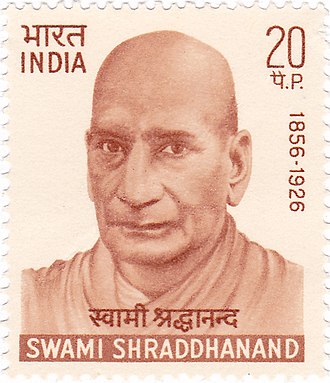
In 1915, Mohandas Gandhi relocated to India after spending 20 years in South Africa. It took him just four years to move from the status of a foreigner to the Independence movement’s leader. In this ascendancy, he surpassed leaders like Gopal Krishna Gokhale, Lokmanya Tilak, Lala Lajpat Rai, Aurobindo Ghose, Abdul Kalam Azad, and Annie Besant. Gandhi achieved this feat by propping up the Khilafat movement and putting that at the same level as the non-cooperation movement for Indian independence.
Two interesting episodes related to Khilafat are mentioned in Vikram Sampath’s Savarkar: Echoes from a forgotten past. The person common in both episodes is Swami Shraddhanand, a disciple of Swami Dayanand Saraswati, the founder of Arya Samaj. Swami Dayanand Saraswati used a process called shuddi to reconvert Hindus back to the fold. After his passing away, this gained momentum under Swami Shraddhanand, who conducted shuddi ceremonies in Punjab and northern India. Vinayak Savarkar used the same shuddhi ceremony in the Andaman jail.

Coming back to Khilafat, Bipin Chandra Pal and Annie Beasant had the foresight to see the trouble this would bring. Lala Lajpat Rai wrote, ‘Indian Muslims are more pan-Islamic and exclusive than the Muslims of any other country of the globe, and that fact alone makes the creation of a united India more difficult than would otherwise be. ‘ Even Jinnah opposed the Khilafat agitation initially.
Despite this, Gandhi would not change his mind. Seeing the energy around the Khilafat movement, Gandhi argued that if Hindus and Muslims united for satyagraha, there would be victory. So, in 1920, he promised Swaraj to the Ali brothers – Muhammad and Shaukat. These were people with a known track record of fomenting trouble.
In the Calcutta session in September 1920, Swami Shraddhanand was on the stage with Shaukat Ali. He heard Shaukat Ali tell a few others in his company the following. “Mahatma Gandhi is a shrewd bania. You do not understand his real object. By putting you under discipline, he is preparing you for guerilla warfare. He is not such an out and out non-violencist[sic] as you all suppose. “
Swami Shraddhanand tried to warn Gandhi that his motives were being misrepresented, but they were not taken seriously.
At the annual session of the Congress in Nagpur in 1920, Gandhi consolidated his position. Muslims stood by Gandhi. They turned up in such large numbers that it looked like a Muslim session. Maulanas recited verses referring to jihad and the killing of kafirs. Again when Swami Shraddhanand told this to Gandhi, he said they were referring to the British and not Hindus.

Sometime after May 1921, the British government intercepted a telegram sent to the Amir of Afghanistan urging him to invade India and not make peace with the British. This was allegedly written by Muhammad Ali, but Muhammad Ali claimed that he did not know Persian or Arabic. At Motilal Nehru’s house, Swami Shraddhanand met Muhammad Ali. Ali took him aside and handed over a piece of paper which was the draft of the telegram intercepted by the British. According to Swami Shraddhanand, the handwriting was Gandhi’s.
Gandhi reached Anand Bhavan the next day, and Swami Shraddhanand asked him about the letter. Gandhi said he does not remember sending such a telegram. What is suspicious about this statement is that Gandhi himself had made the following statement earlier, ‘I would in a sense, certainly assist the Amir of Afghanistan, if he waged war against the British Government.’
In January 1921, Gandhi said that Hindu sadhus have to sacrifice their all for the sake of Khilafat. According to him, every Hindu had a duty to save Islam from danger. Six months before this, he had warned that if Hindus did not help Muhammadans during their time of trouble, their own slavery was a certainty.
Look what happened later that year. The Amir of Afghanistan did not invade India. Also, India did not achieve Swaraj by Gandhi’s promised date to the Ali brothers. The Hindus of Malabar paid the price for that unholy alliance with their lives.